|
Number 5 'Hands Of the Ripper' (1971) Director, Peter Sasdy.
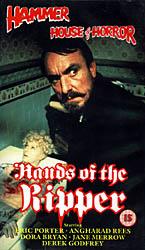
PLOT?
Jack the Ripper's daughter (Angharad Rees), spies her - ludicrously moustached - father, strangle her mother, before throwing himself into the Thames; followed by an angry mob of stage-school Cockney's, carrying lighted torches.
Orphaned, she is taken in by the poncey, Dr. Pritchard (Eric Sikes). However, the poor girl has grown up with 'issues' and now resorts to murder whenever she is confronted with either 'hands' or 'fire'.
The Doctor continually poo-poo's the cackles of superstitious, Victorian guttersnipes, and hopes to make a name for himself, by curing the girl with Freudian psychoanalysis. However, since the opportunity of seeing either hands or fire is less than rare, loads of people get killed, ususally whenever the Doctor turns his back.
TOMATO SAUCE AND EYE-ROLLING?
Surprisingly large amounts of gore, actually. People get impaled on things, fall on swords, and, of course, there's the classic, industry-standard mirror stabbing and hatpin through the eye.
UNPLEASANT, GRATUITOUS NUDITY?
Well, of course this is the 70's, and a film wouldn't be film without a quick glimpse of some milky, female flesh. Fortunately, that's all we get.
DOES IT MAKE ANY SENSE?
This is a Hammer Horror film of the old school tradition, and it therefore mixes competent filmmaking with a dull, predictable plot. It's the rather tired fable of the arrogant scientist meddling with what he cannot possibly understand. Damn him, for bothering to get educated.
However, it is nice to get a bit of closure on that Jack the Ripper mystery. Apparently, he was just someone's dad...
Number 4 'The Creeping Flesh' (1972) Director, Freddie Francis.
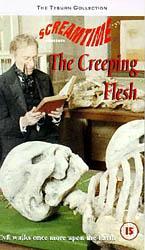
PLOT?
Professor Hildern (Peter Cushing) returns to London with a skeleton unearthed in New Guinea. He hopes it will help him discover the origins of man, but (would you believe it?), it turns out to be the remains of Shish Kang, 'the Evil One'.
Hildern's jealous, half-brother, James (Christopher Lee), who routinely beats up the inmates of his asylum, writes to Hildern to tell him that his wife has died. He travels to James' house, and a lot of shouting and petty sibling rivalry ensues.
Meanwhile, the rubber skeleton of Shish Kang, reanimates itself somehow, dons a cape and takes a quick constitutional to James' house. When he finally arrives, he politely knocks at the door (?) and waits to be entertained. The two lads, presumably unaware that pure evil would be so courteous, answer the door and are forced to start a fight with him. More shouting, and some things burn down.
TOMATO SAUCE AND EYE ROLLING?
Quite disappointing, really.
'Do you believe in evil, Doctor? I do not mean evil as it is commonly understood. I mean evil as a living organism..." Cushing demands from Lee, at one point.
Yet, it turns out that evil incarnate just wants to get the finger back that Cushing nicked off him. Not much killing to be done there, then. He is quite ugly, though. Think of Eastender's Dean Gaffney, gushing blood from his eyes.
UNPLESANT, GRATUITOUS NUDITY?
Well, the skeleton's skinny rump is on display for most of the film, but otherwise, it's all quite tame. However, some rather childish laughs are there for the taking, thanks to the inclusion of Shish Kang's rather phallic missing digit.
DOES IT MAKE ANY SENSE?
Well, obviously, there are some points you'd prefer to have cleared up - like what exactly Shish Kang actually is, and how he comes to have magical powers.
Also, for all his apparent 'evil', he doesn't actually do anything particularly bad, preferring instead, to ramble around the English countryside.
Maybe, he smells evil, who knows?
Number 3 'The Blood on Satan's Claw' (1970) Director, Piers Haggard 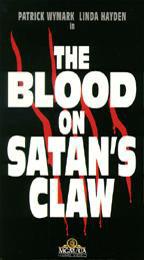
PLOT?
It's 17th century rural England, and roguish simpleton, Ralph (Barry Andrews), is ploughing the lower field, when he uncovers the bony remains of 'a fiend'. And we know it's a 'fiend', because we're told it is. Whatever it is, it's a fairly loathsome drab, with a worm crawling across its one intact eyeball.
In any case, once Ralph returns to the field with a visiting Judge (Patrick Wymark), they discover the thing is missing.
Meanwhile, local squire, Peter (Simon Williams), swans about with his blushing, and fantastically eye-browed, bride (Tamara Ustinov). His ultra-prim aunt (Avice Landon), insists the girl sleep in the unused, attic room, where she is summarily attacked by something lurking under the floorboards, and driven quite insane. The next morning, Peter catches a glimpse of her hand, which has been transformed into 'some manner of bestial claw'.
At the same time, a load of 35 year-old school children hang around the some church ruins, dancing badly, in order to conjure up the devil. Instead, they grow enormously hirsute.
They also have possession of the now fully uncovered fiend. And we are told he's missing a leg.
TOMATO SAUCE AND ROLLING?
Poor old Ralph, who first discovered the fiend, goes on to uncover some hair on his left leg, which he seems to find outrageous. Foolishly, he decides to lock himself in the attic room - which proves to be a mistake.
The Judge decides that he will deal with the evil forces, by way of strange and 'undreamt of' means. In the end, he turns up at the ruins, at first brandishing the good book, but he later gives up on this tact, and kills the 'fiend' with the use of some dogs and an enormous, double-edged sword.
UNPLEASANT, GRATIOUS NUDITY?
Plenty. A load of the apparently innocent local schoolgirls (who all look like your mum's friends) turn up and put on a rather slapdash series of dance licks, in the nude. Sagging flesh and choppy legs, one an' all.
The fella's all strip off as well, but luckily for the viewing audience, they are all taken over by 'The Devil's Skin', and as such, hide their chaps under He-Man-style furry pants.
DOES IT MAKE ANY SENSE?
Yes, I guess so. The moral is something about not doing gardening, I think.
Number 2 'Theatre of Blood' (1973) Director, Douglas Hickox 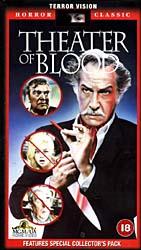
PLOT?
A bit unlikely, this one. A demented Shakespearean actor, with a excellently stylish name, Edward Lionheart (Vincent Price), adds murder to his repertoire when he takes his revenge on the eight critics who slighted him, ruining his career.
His loyal, equally demented, and rather lovely, daughter (Diana Rigg), aids him in his hopelessly contrived plan, which involves using Shakespeare's plays against them. Oh, the irony.
So, just as with 'Julius Caesar', one critic is stabbed to death during the 'ides of March', and another killing, based on 'Cymbeline', involves a critic having his head sawn off, whilst in bed with his wife.
In a particularly nasty episode, Lionheart uses 'Titus Andronicus' as his model, and forces porky, Robert Morley to eat a pie made out of his two beloved poodles, whom he refers to throughout as his 'babies'. The big fool.
The Lionheart's are also helped in their crazy schemes by a bunch of enraged tramps, who live in the adjacent sewer to them.
TOMATO SAUCE AND EYE ROLLING?
Oh, yeah, the orange blood abounds in this one.
Watch out for the police (who are all suspiciously well read), as they turn up at the various murder sites and look oddly disinterested at the bizarrely mutilated victims, which leads me to believe that these sort of thematic murders aren't actually as uncommon as you might otherwise have thought. And although the police seem to know exactly who is committing the crimes and why, they seem strangely unwilling to do anything about it. So, a bit like real police, then.
UNPLEASENT, GRATUITIOUS NUDITY?
Nothing good.
During the poodle-eating scene, we are privileged to see one of Robert Morley's tits.
Also, a couple of the tramps reveal their unkempt bras and pants.
DOES IT MAKE ANY SENSE?
Well, yes, there is a point to this one. It is an excellent vehicle for Vincent Price and Diana Rigg to wear silly wigs and get paid. Which is probably pretty good work if you can get it.
|
|
Number 1 'Tales that Witness Madness' (1973) Director, Freddie Francis 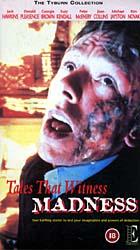
PLOT?
Several. None of which make much sense.
The head of a psychiatric institute (Donald Pleasence) leads another doctor around the wards, whilst telling the stories of four of his patients.
The audience is first shown a dysfunctional couple, who seem to continually argue about their young son's imaginary friend - which happens to be an invisible tiger. But, the big shock comes as we discover that the tiger isn't actually imaginary at all. Ahhhh, you see, no one saw that one coming.
The second is the story is of an owner of an antique shop (Peter McEnery), who begins living a strange double life, courtesy of a penny-farthing bicycle, and a photograph of his Uncle Albert, that moves occasionally. Some other stuff happens and the shop burns down - all for no readily apparent reason.
The third instalment is truly excellent, and involves the young, Joan Collins finding her marriage and her life under threat from a tree. No, really.
And lastly, the story of a publicist (Kim Novak), who arranges a dinner party for her client, but unwisely leaves the dinner preparations to the client's mysterious, exotic, companion (Leon Lissek). With the end result that Novak's daughter ends up on the menu. That's foreigners, for you.
TOMATO SAUCE AND EYE ROLLING?
The first of the stories is rather perfunctory, but contains the most graphic depiction of violence, and is almost certainly the work of a nine-year-old boy. Especially, the shot of the child sitting calmly, as his parents are dismembered in front of him. Nice.
The film really needs this story, however, because the next two make almost no sense at all.
In the final story, we are subjected to tremendously ugly people's terrible table manners, which I personally found rather gruelling.
UNPLESANT, GRATUITIOUS NUDITY?
Joan Collins shags the tree.
In fact, Collins suffers a range of indignities in this film which really have to be seen to be believed, from her wardrobe (the baby-doll night-dress and hair ribbon ensemble, is the killer) to her ultimate fate, where despite her efforts, she actually loses her husband to the tree. That said, its a bloody nice one.
DOES IT MAKE ANY SENSE?
None at all.
After hearing all these ill-conceived, thinly plotted stories, we then find out that they are completely untrue. And that's the end of the film. It's just the stuff of a madman's dreams.
Perhaps, the bigger mystery is how the film ever got into production in the first place. |